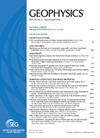地力随钻钻头震源的概念与应用
IF 3.2
2区 地球科学
Q1 GEOCHEMISTRY & GEOPHYSICS
引用次数: 6
摘要
四十年来,为了随钻地震(SWD)的目的,对钻头震源的使用进行了广泛的评估和研究。然而,在初始扩散阶段之后,由于与在不同钻探条件下获得的钻头信号的信噪比变化有关的问题,钻头反向垂直地震剖面(RVSP)的常规应用已经下降。因此,已经致力于改进参考信号的记录。最近的技术发展使得能够在靠近钻头的井下位置直接进行地面力引导测量,从而能够可靠地估计远场钻头辐射特征。近场震源下方地面力的知识不仅是钻头震源开发的关键方面,也是传统地震震源开发的重要方面。由地面力获得的SWD去卷积结果与仅记录运动振动(如加速度)获得的结果不同。地面力和粒子速度通过近场中的复阻抗联系在一起,它们一起提供双重测量。此外,在岩石断裂过程中,在存在钻头位移作用和穿透的情况下,地面力在钻头-岩石界面处提供了具有有效耦合条件的信号。钻头源处阻抗的分析包括钻柱反射,这些反射在参考钻柱导频信号中观察到,并通过使用适当的力学模型进行模拟。通过使用地面力和运动信号进行反褶积和相关,以不同的方法处理真实地震信号,从而改进了源信号的提取,有效地去除了不期望的导频波场,并在井间调查中对钻头地震波场进行了更干净的估计。本文章由计算机程序翻译,如有差异,请以英文原文为准。
Seismic-while-drilling drill-bit source by ground force: Concept and application
For four decades, the use of the drill-bit seismic source has been evaluated extensively and investigated for seismic-while-drilling (SWD) purposes. After an initial diffusion phase, however, the routine application on drill-bit reverse vertical seismic profiling (RVSP) has declined because of issues related to variability in the signal-to-noise ratio of drill-bit signals obtained with different drilling conditions. Consequently, additional efforts have been dedicated to improving the recording of reference signals. Recent technology developments enable direct ground-force pilot measurements at downhole positions close to the bit, which enable reliable estimations of the far-field drill-bit-radiated signature. The knowledge of the ground force below the source in the near-field is a key aspect not only for the exploitation of the drill-bit source but also for conventional seismic vibrator sources. The SWD deconvolved results obtained by the ground force are different from those obtained by recording only motion vibration, such as acceleration. The ground force and particle velocity are linked by a complex impedance in the near-field, and together they provide dual measurements. In addition, the ground force provides signals with effective coupling conditions at the bit-rock interface in the presence of the drill-bit displacement action with penetration during rock fracturation. The analysis of the impedance at the bit source includes the drillstring reflections, which are observed in the reference drillstring pilot signal and are simulated by using an appropriate mechanical model. The processing of real seismic signals with different approaches by deconvolution and correlation using ground-force and motion signals produces improvements in the extraction of the source signal, with effective removal of the undesired pilot wavefields, and with cleaner estimations of the drill-bit seismic wavefields in a crosswell survey.
求助全文
通过发布文献求助,成功后即可免费获取论文全文。
去求助
来源期刊

Geophysics
地学-地球化学与地球物理
CiteScore
6.90
自引率
18.20%
发文量
354
审稿时长
3 months
期刊介绍:
Geophysics, published by the Society of Exploration Geophysicists since 1936, is an archival journal encompassing all aspects of research, exploration, and education in applied geophysics.
Geophysics articles, generally more than 275 per year in six issues, cover the entire spectrum of geophysical methods, including seismology, potential fields, electromagnetics, and borehole measurements. Geophysics, a bimonthly, provides theoretical and mathematical tools needed to reproduce depicted work, encouraging further development and research.
Geophysics papers, drawn from industry and academia, undergo a rigorous peer-review process to validate the described methods and conclusions and ensure the highest editorial and production quality. Geophysics editors strongly encourage the use of real data, including actual case histories, to highlight current technology and tutorials to stimulate ideas. Some issues feature a section of solicited papers on a particular subject of current interest. Recent special sections focused on seismic anisotropy, subsalt exploration and development, and microseismic monitoring.
The PDF format of each Geophysics paper is the official version of record.
 求助内容:
求助内容: 应助结果提醒方式:
应助结果提醒方式:


